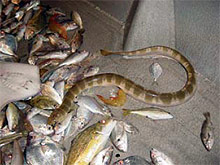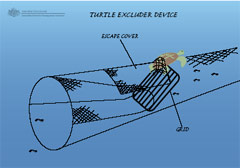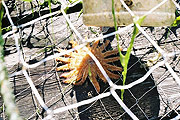
|
||||||||
|
| When fishers target certain species they want to catch they also can catch other species by accident, these non-target species are called bycatch. In Australia, our fisheries are trying to reduce bycatch to avoid waste and keep our marine resources healthy. | |
Marine animals and plants are sometimes caught as bycatch in commercial, recreational and Indigenous fisheries because most conventional fishing methods can catch a range of species, both target and non-target. For example, bycatch occurs when a commercial fisher is trawling for prawns and also catches unwanted fish, or when a recreational fisher is angling for a snapper and accidentally catches a toad fish. Most bycatch are finfish, sharks, stingrays or invertebrates (crabs, shells, sea stars). In some cases the fish caught as bycatch by one fishery may be a target species for another fishery. Most bycatch is returned to the ocean but depending on the species and fishery it can be returned alive or dead. Sometimes marine mammals (sea lions, seals, dolphins), marine reptiles (marine turtles, sea snakes) or seabirds (albatrosses, petrels, pelicans) are caught as bycatch. Even though these species are seldom caught in most fisheries there is concern because these species tend to be slow growing, long lived and have few young. This means that they tend to recover slowly from population declines. Some of these species are considered vulnerable to local and even global extinction because of a range of human activities and environmental issues. |
 Shark and fish bycatch caught during prawn trawling. (courtesy CSIRO Marine and Atmospheric Research) |
Working together to manage and reduce bycatch
In Australia, our fisheries are trying to reduce bycatch to:
- • avoid waste;
• reduce work for fishers in sorting their catch;
• avoid damage to the catch from bycatch species;
• ensure long-term survival of bycatch species;
• avoid impacts on species protected under Australian law; and
• ensure the catch of a bycatch species does not adversely affect the marine ecosystem, for example, through the removal of key prey species from a foodweb.
By working together, fishers, makers of fishing gear, researchers, government and non-government organisations have modified fishing gear and practices to help reduce bycatch.
Australian fishers are reducing bycatch by:
- • using innovative fishing gear that allows bycatch to escape, avoid being caught or reduces harm if they are caught;
• fishing in different places or times where the bycatch species do not occur or are less common; and
• changing how they use their fishing gear to avoid bycatch, or if bycatch is caught then reduce the harm to the species.
Turtle Excluder Devices (TEDs) — a success story
 Diagram of a Turtle Excluder Device in a prawn trawl net. (diagram courtesy of AFMA) |
In the past, prawn trawlers occasionally caught turtles as bycatch because turtles live in the same areas as prawns targeted by the trawlers. In Australia, all boats that use trawl nets to catch prawns in tropical waters must now have Turtle Excluder Devices (TEDs) fitted to their nets. TEDs are a grid within the net. If a turtle enters the net this grid guides the turtle to an opening in the net so it can escape. But the prawns pass straight through the grid to the end of the net and are caught. The use of TEDs has dramatically reduced the bycatch of turtles in Australian tropical prawn trawl fisheries. |
Where to next? It is important to keep looking for new and better ways of reducing bycatch, to benefit the fishers and the marine environment. As fishers it is important to be aware of what you can do to avoid catching unwanted species. Find out more |
 This sea star has been trapped in a crab pot. |
• Bureau of Rural Sciences, Fisheries and Marine Sciences:
www.daff.gov.au/fisheries_marine• Department of Agriculture Fisheries & Forestry:
www.daff.gov.au• Department of the Environment and Water Resources (DEW), Coasts and Oceans:
www.deh.gov.au/coasts/index.html• OceanWatch, SeaNet:
www.oceanwatch.org.au• Fisheries Research and Development Corporation:
www.frdc.com.au• CSIRO Marine and Atmospheric Research:
www.cmar.csiro.au• Australian Fisheries Management Authority:
www.afma.gov.au• Department of Primary Industries, New South Wales, Fishing and Aquaculture:
www.dpi.nsw.gov.au/fisheries
• Department of Primary Industries and Fisheries, Queensland, Fisheries:
www.dpi.qld.gov.au/cps/rde/xchg/dpi/hs.xsl/28_ENA_HTML.htm• Department of Primary Industries, Victoria, Fishing and Aquaculture:
www.dpi.vic.gov.au/dpi/nrenfaq.nsf• Primary Industries and Resources, South Australia, Fisheries:
www.pir.sa.gov.au/sector7.shtml• Department of Primary Industries and Water,Tasmania, Sea Fishing & Aquaculture:
www.dpiw.tas.gov.au/inter.nsf/• Department of Fisheries, Western Australia:
www.fish.wa.gov.au/index.php• Department of Primary Industries, Fisheries and Mines, Northern Territory, Fisheries:
www.nt.gov.au/dpifm/Fisheries/
